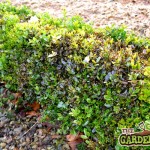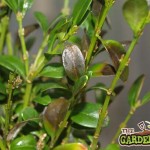A disease that has become more common in recent years is box blight and it is a concern for many gardeners who cherish their old box hedging or topiary bushes.
The disease is caused now by two organisms, both of which are fungal. These fungi attack box hedging plants and can be difficult, if not impossible to cure.
- Box Blight
- Cylindrocladium buxicola
- Volutella buxi
The more common, but luckily less threatening from of box blight is caused by Volutella buxi. This fungus can be found on the underside of the foliage of infected plants and caused the box hedging plants to die up and turn brown, eventually leading to bare patches on the plant. The spore themselves are tiny pink spheres, as stated, found on the under side of the foliage. and these are the most recognisable features of the organism.
What make Volutella less treathening is that it can only enter the plant through an open wound, such as a fresh cutting, otherwise it cannot attack the plant.
The more serious fungus related to box blight is Cylindrocladium buxicola. This is a more recently occurring fungus and is found in Ireland. The symptoms recognised include dark brown patches on the foliage with greyish fungal growth on the underside of the leaves.
Treatment is anything but certain, but their are a number of things that you can do to reduce the risk of box blight:
1. Avoid pruning box in wet conditions, this is because the spores need water to spread and you will encourage this through pruning
- When you do prune box, be sure to clear away and burn cuttings to prevent any possible spread
2. General garden hygiene is also important against the fight on blight. If you do notice infection you should cut it out and again burn it. Also, stay vigilant and listen out for blight warnings online.
3. Remove any old foliage that has fallen from your box hedging over the winter, this foliage could hold spores that could infect the plant.
4. There is some chemicals that can be used to control blight but non that are available to domestic users. Fungicides with the following agents can be effective:
- Difenoconazole (Westland Plant Rescue Control)
- Tebuconazole (Bayer Garden Multirose Concentrate 2
- Triticonazole (Scotts Fungus Clear Ultra)
- Penconazole
5. Improve airflow and circulation in and around your box plants. Give your plants space to breath, and don’t place too close to them. You should also reduce the number of cuts you make as more pruning leads to dense growth and worse air flow
6. Minimise use of Nitrogen based fertiliser as these encourage fungal growth and avoid watering plants from above as this will wet the foliage and encourage the spread of the blight
7. Check before you buy; box blight can be found in garden centre stocks and you should pay close attention to the stock before buying. It it also suggested that, after buying box from a garden centre you should put the plants in quarantine for 3 weeks to see if any spores develop.
8. Consider growing blight resistant varieties
- Buxus Faulkner
- Buxus Rococo
- Consider box alternative
- Berberis
- Taxus
- Lonicera nitida
- Ilex crenata
- Euonymus fortunei


